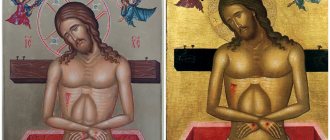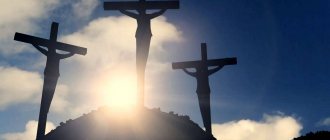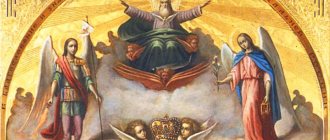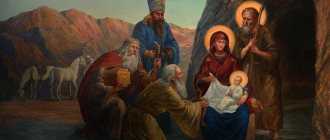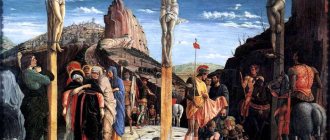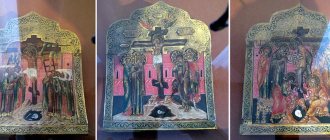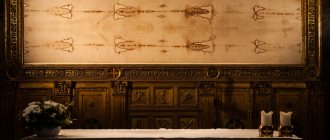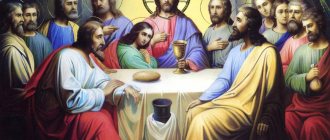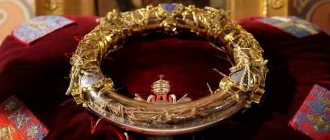History of the image
History has not preserved the exact date when the icon of Jesus Christ the Pantocrator was painted.
All that remains is evidence of its external appearance, the prototype of which was the Image of the Savior Not Made by Hands, glorified in the 4th century. It was during this period that several icons of the Lord were discovered in the catacomb churches. On them He was depicted as the Good Shepherd, the youth Emmanuel and even Orpheus. From the 4th century, icon painters began to paint Christ in the image of a radiant youth in white robes, surrounded by a host of apostles.
More about the icons of the Lord:
- Icon of the Holy Trinity
- Icon of the Exaltation of the Holy Cross
- How and when does the icon of Jesus Christ help?
And a little later, the Almighty is conveyed to us as an adult man with a long beard, holding a book in one hand, the other extended to the people in the gesture of an orator or preacher. Since the 5th century, Jesus has been depicted as a king.
The icon of the Almighty greatly outraged the heretics who did not recognize the divine essence of Christ. They considered Him an ordinary man upon whom the Holy Spirit had descended.
But the Ecumenical Councils, which affirmed the Orthodox doctrine, testified that Jesus Christ is the God-man of divine and human nature at the same time. He appeared into the world in the form of a man in order to, through His Life, heal humanity from sin and open the door to the Kingdom of Heaven.
In the 8th century, under the reign of Leo III the Isaurian, an iconoclast and heretic, Orthodox icons were actively destroyed, and Christians were imprisoned and subjected to terrible torture and execution. Soon, with God's help, the heretics were defeated and condemned at the VII Ecumenical Council. Since then, the icon of the Savior Almighty has become a symbol of the truth of the Orthodox faith.
In modern churches, the Image of Pantocrator is traditionally placed above the central dome of the temple and in the center of the iconostasis.
Lord Almighty. St. Vladimir's Cathedral in Kyiv
What you need to know about the icon
First of all, people must understand that an icon is not a portrait. There is no detailed description of Christ's appearance in the Gospel. Nevertheless, His appearance is not just an invention of the artists who painted icons. There are descriptions from contemporaries that lift the veil of secrecy and report that Jesus had brown hair, a reddish beard, blue eyes, tall stature and a pleasant, calm manner of speaking.
On a note! No one has seen the Lord, but when it is necessary to depict the Most High on an icon, icon painters use the image of Jesus Christ as the incarnate hypostasis of the Creator.
What does it look like
The appearance of Jesus Christ on the “Pantocrator” icon, which means “Almighty” in Greek, is quite realistic; individuality can be seen in his facial features. This suggests that the image was painted from miraculous images that arose without human participation. The generally accepted canons of iconography depicting the Savior were formed by the 9th century.
The left and right halves of the face are asymmetrical. This makes a certain sense. So, the left side is lighter, it radiates kindness and philanthropy. The arch of the eyebrow is curved naturally, the eye looks sweetly. The right one looks completely different - a peering gaze, an intensely raised eyebrow. The face on this side is darkened. This concept well reflects the dualism of the nature of the Messiah - divine and human. He combines the Judge and the All-Merciful Creator.
Icon of Jesus Christ "Pantocrator"
On the icon, a halo is drawn around the head of Jesus, which once again emphasizes his origin from heavenly powers.
Interesting! The halo was originally decorated with stars. Later, the tradition came to write letters on it that stand for “I Am Who I Am.”
The gestures in the image are also not random. Three folded fingers symbolize the Holy Trinity, and two raised fingers symbolize the human and divine principles. The right hand blesses all Christian believers, and the left hand contains the Gospel, which indicates the power of the King of Heaven over the world and his role as Teacher.
Description of the image
“Lord Pantocrator” is not an icon as such, but an iconographic type of depiction of Christ.
He is shown in the image of a royal person, standing or sitting on a throne. In His left hand He holds a book (scroll or Gospel), symbolizing preaching, and His right hand is raised in a gesture of blessing. There are also shoulder and waist versions of His image.
Important! The Almighty is often called in Greek “Pantocrator”, which translated means “All-Powerful and Almighty, Ruler of the World, Ruler of everything.”
The meaning of the word pantocrator
Examples of the use of the word pantocrator in literature.
The green book - hardly larger than my palm and no thicker than my middle finger - turned out to be a collection of stories about the righteous, with many enamel images of ascetic pantocrators and hypostases in sparkling robes, with black halos above their heads.
I tell the fathers about the symbolism of the temple, explain where everything was, show the frescoes - Oranta in the conch, Pantocrator in the dome, evangelists on the sails, the Last Judgment.
Yaroslav was silent for the first time, but again came to Sofia and again observed an amazing picture: one, sticking out his tongue, fits the cube to the cube so tightly that it is impossible to get the needles through, and the other, above, throws smalt randomly and arbitrarily, and while the one below is fussing still above only one figure, he at the top had already finished Pantocrator and began to work on his heavenly guards - the archangels, and all of this was clumsy, rough, disheveled, disheveled, like himself, and again Mischilo shrugged his shoulders and whispered something - that's judgmental.
Pantocrator, Oranta, the Eucharist with Christ painted twice and the apostles who ran to God for his body and blood - this is how the priests themselves imagined the decoration of the cathedral.
Sculpted figures of Egyptian gods and god-kings, Madonnas and Pantocrators of Byzantine mosaics, Bodhisattvas and Lohans of China, seated Khmer Buddhas, steles and statues of Copan, wooden idols of tropical Africa - they all have one thing in common: deepest tranquility.
They laid mosaic inscriptions near the Pantocrator, on the ripids, near the archangels, in a large arc above Oranta, above the Eucharist.
Almighty - Pantocrator sits on the throne, judges, makes laws, like Zeus, as well as the king of the earth.
With his right hand, Pantocrator blesses the people gathered below, and in his left hand he holds the closed book of the New Testament, which he will open on the day of the Last Judgment.
The Metropolitan served a prayer service, glory and praise ascended to God, the people of Kiev with lighted candles stood silently in the cathedral, bells sounded, beats and covers, a choir sang, through the incense smoke from high above the Pantocrator looked sternly and Oranta’s frightened and stubborn eyes burned over the gathered people of Kiev, who, in order to look at it, closed the trade, pottery, leather and weapons workshops.
That is why we call God Pantocrator, Pantocrator - Almighty, in Greek.
The Mother of God with the face of Theodora, Christ Pantocrator in the guise of a basileus - this is the real place.
Christ Pantocrator will help you to dissolve the salt of my thoughts with appropriate reproaches, warnings and warnings.
Why doesn't Christ Pantocrator turn the fingers of the basileus into bundles of lightning!
In the very upper part of the dome vault, in a large ring, the image of Christ Pantocrator, or Pantocrator in Greek, sparkled with a multi-colored musia.
He lived with his own colors, had his own intentions to fulfill, made Pantocrator look like Agapit.
Source: Maxim Moshkov library
Ancient icon
The very first image is considered to be an icon from the Sinai Monastery. Christ is depicted in traditional vestments, seated on a throne with a pillow and stool at his feet.
The throne is an attribute of royal dignity. This is exactly how we will see the Savior on the Day of the Last Judgment, when He appears on the sinful earth in order to carry out the Judgment of God on the living and the dead.
In icon painting, there are several interpretations of the Almighty: Manuel the Savior, the Savior in Power, the Soul Savior, the Merciful.
Image of Jesus Christ Lord Almighty. Temple icon
History of the icon
It so happened that paintings and mosaics with the face of the Lord appeared much later than written mentions of Jesus Christ. This is due to the prohibition of the Old Testament church to depict the face of the Creator. The first to paint icons depicting the Savior were the servants of Byzantine churches. This happened in the period from the 4th to the 6th centuries. The oldest image of Pantocrator that has survived to this day is located in the Sinai Monastery. It was created in Constantinople. According to legend, the icon was given as a gift to the monks by Emperor Justinian. But it was discovered only in the 19th century.
This icon was painted in a unique manner, in many ways similar to the portrait technique. The wax image was under a layer of additional drawings made for the purpose of updating at different times. It was cleared already in the 60s of the 20th century during the restoration process. In the 7th century, the image of the Savior appeared on gold coins at the suggestion of Emperor Justinian. In terms of type, the embossed image, which was elevated to the status of an imperial symbol, was very similar to that very icon of Christ Pantocrator in the Sinai monastery.
Mosaic face of Christ “Pantocrator” in the central dome of the Church of the Savior on Spilled Blood
Subsequently, many copies were made from the image, which today can be found in every temple and not only. Every Christian believer strives to have an icon of the Almighty at home. After all, God is the best healer of spiritual wounds.
Meaning and help
Jesus Christ is the main healer of human souls and bodies, who knows everything, and our prayer should be directed to Him first and foremost.
Before the image of the Almighty, grateful Christians offer thanks to the Lord for His merciful help and support. Others pray for blessings and help:
- in the healing of spiritual and physical ailments;
- about giving consolation in sorrows and imparting spiritual benefits;
- about getting rid of sinful thoughts and mental traumas;
- about guidance on the true path;
- about protection from evil people and deception on their part;
- about protection from cruelty and meanness;
- about preserving the marriage union and achieving harmony in it.
Advice!
You can pray before the Face of Pantocrator both for yourself and for your family, loved ones, friends and acquaintances. But before starting the prayer, it is recommended to read the “Our Father”, and then with sincere and pure thoughts, and an open heart, read the prayer. Church history records many miracles and healings that occurred after praying before the Face of the Almighty.
Lord Pantocrator, Sucevita Monastery in Romania
Orthodox online store Svyatsy.Org - icons of Jesus Christ Pantocrator (Pantocrator).
Meaning of the icon
For Christians, the icon of “Christ Pantocrator” is a kind of symbol of the promise that justice and goodness will definitely triumph in the bright Kingdom of Heaven. It depicts Jesus in all his greatness and power.
With His appearance, He seems to remind every person that they need to live according to the commandments and renounce sinful deeds in order to be reunited with their Father at the end of their earthly journey.
Orthodox online store Svyatsy - Icons of Christ Pantocrator.
